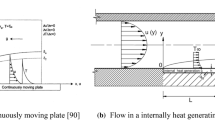Abstract
Coupled and decoupled conjugate heat transfer (CHT) studies are carried out to imitate experimental studies for heat transfer measurement in hypersonic flow regime. The finite volume based solvers are used for analyzing the heat interaction between fluid and solid domains. Temperature and surface heat flux signals are predicted by both coupled and decoupled CHT analysis techniques for hypersonic Mach numbers. These two methodologies are also used to study the effect of different wall materials on surface parameters. Effectiveness of these CHT solvers has been verified for the inverse problem of wall heat flux recovery using various techniques reported in the literature. Both coupled and decoupled CHT techniques are seen to be equally useful for prediction of local temperature and heat flux signals prior to the experiments in hypersonic flows.










Similar content being viewed by others
Abbreviations
- C:
-
Specific heat at constant, kJ/kg K
- E:
-
Total specific energy, kJ/kg
- e:
-
Specific internal energy, kJ/kg
- H:
-
Total specific enthalpy, kJ/kg
- h:
-
Specific enthalpy, kJ/kg
- k:
-
Thermal conductivity, W/m K
- L:
-
Length, m
- M:
-
Mach number
- p:
-
Pressure, N/m2
- \({\dot{\text{q}}}\) :
-
Heat flux, W/m2
- Pr:
-
Prandtl number
- R:
-
Universal gas constant
- Re:
-
Reynolds number
- S:
-
Source term
- s:
-
Sutherland’s constant
- St :
-
Stanton Number
- T:
-
Temperature, °C
- u:
-
X-direction velocity, m/s
- v:
-
Y-direction velocity, m/s
- x, y:
-
Cartesian co-ordinate system
- λ:
-
Courant number
- γ:
-
Specific heat ratio
- μ:
-
Dynamic viscosity, kg/ms
- τ:
-
Shear stress, N/m2
- ρ:
-
Density, kg/m3
- δ:
-
A parameter in AUSM-δ scheme
- ∞:
-
Freestream quantities
References
J.D. Anderson Jr, Hypersonic and High-Temperature Gas Dynamics, AIAA Education Series, 2nd edn. (Virginia, 2006)
S.D. Abram, Conjugate Problems in Convective Heat Transfer (CRC Press, Taylor and Francis Group, Boca Raton, 2010), pp. 249–264
V. Chandrashekhar, Y.M. Jayathi, M. Sanjay, A mesh-less finite difference method for conjugate heat conduction problems. Trans. ASME J. Heat Transf. 132(8), 0813031–08130313 (2010)
M.S. Liou, A sequel to AUSM: AUSM+”. J. Comput. Phys. 129, 364–382 (1996)
K.P. Rajesh, K.D. Manab, Effect of geometry on the conjugate heat transfer of wall jet flow over a backward-facing step. Trans. ASME J. Heat Transf. 131(11), 114501–114506 (2009)
G.V. Kuznetsov, V.Y. Polovnikov, The conjugate problem of convective-conductive heat transfer for heat pipe lines. J. Eng. Thermophys. 20(2), 217–224 (2011)
M. He, P. Bishop, A.J. Kassab, A. Minardi, A coupled FDM/BEM solution for the conjugate heat transfer problem. Numer. Heat Transf. Part B Fundam. 28(2), 139–154 (1995)
D.A. Kontinos, Coupled thermal analysis method with application to metallic thermal protection panels. J. Thermo Phys. Heat Transf. 11(2), 173–181 (1997)
C.P. Rahim, A.J. Kassab, R.A. Cavalleri, Coupled dual reciprocity boundary element/Finite volume method for transient conjugate heat transfer. J. Thermo Phys. Heat Transf. 14(1), 27–38 (2000)
B. Hassan, D. Kuntz, D.L. Potter, Coupled fluid/thermal prediction of ablating hypersonic vehicle, in 36th AIAA Aerospace Sciences Meeting and Exhibit, Reno, NV, Paper No. 98-0168, 12–15 January, 1998
F. Pietro, D. Domenic, A numerical method for conjugate heat transfer problems in hypersonic flows, in 40th AIAA Thermophysics Conference, Seattle, Washington, Paper No. 2008-4247, 23–26 June, 2008
D.L. Schultz, T.V. Jones, Heat Transfer Measurements in Short-Duration Hypersonic Facilities. AGARDograph-AG-165, 1973
W.J. Cook, E.J. Felderman, Reduction of data from thin film heat transfer gauge: a concise numerical technique. AIAA J. 4, 561–562 (1966)
J. Blazek, Computational Fluid Dynamics: Principles and Applications (Elsevier, Oxford, UK, 2001)
R. Peyret, T.D. Taylor, Computational Methods for Fluid Flow (Springer, New York, 1983)
H.K. Veersteeg, W. Malalasekera, An Introduction to Computational Fluid Dynamics (Finite Volume Method) (Longman Scientific and Technical and Wiley, New York, 1995)
K. Vinayak, M. Viren, K.P.J. Reddy, Effectiveness of forward facing spike for drag reduction on a large angle blunt cone in hypersonic flow. J. Spacecr. Rocket. 43(3), 542–544 (2010)
J. Taler, Theory of transient experimental techniques for surface heat transfer. Int. J. Heat Mass Transf. 39(17), 3733–3748 (1996)
Author information
Authors and Affiliations
Corresponding author
Rights and permissions
About this article
Cite this article
Sahoo, N., Kulkarni, V. & Peetala, R.K. Conjugate Heat Transfer Study in Hypersonic Flows. J. Inst. Eng. India Ser. C 99, 151–158 (2018). https://doi.org/10.1007/s40032-017-0353-2
Received:
Accepted:
Published:
Issue Date:
DOI: https://doi.org/10.1007/s40032-017-0353-2




